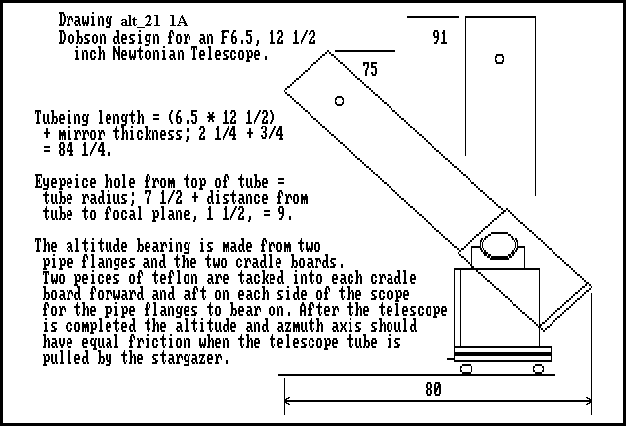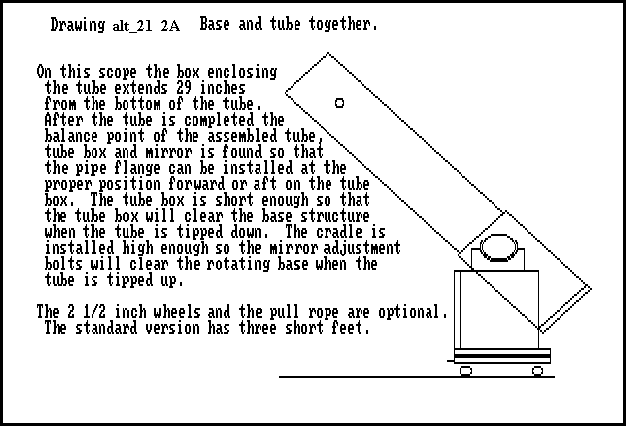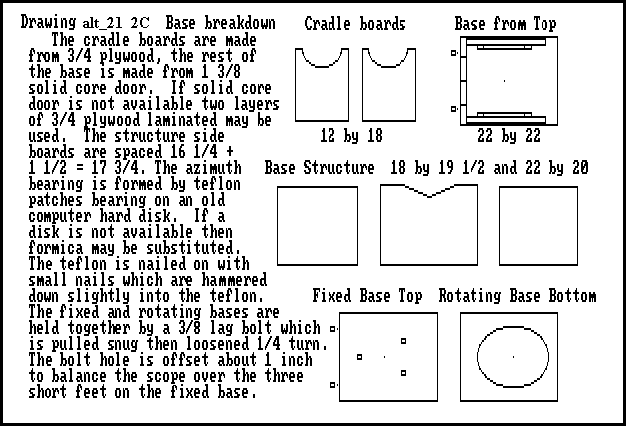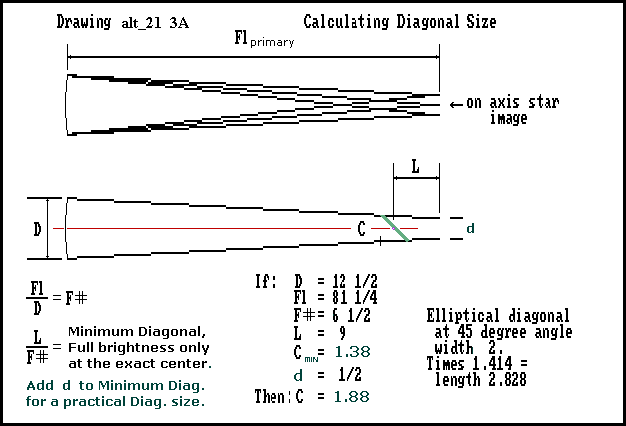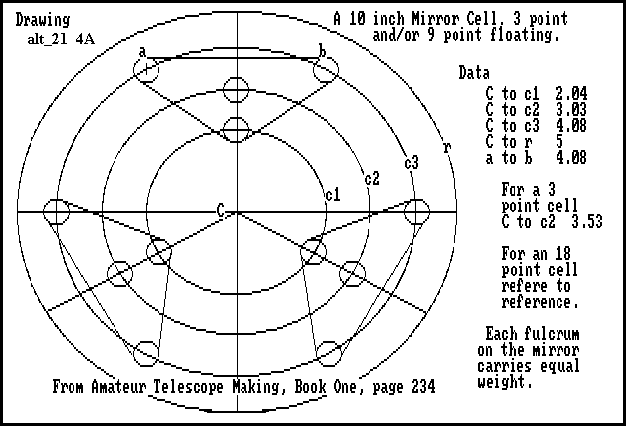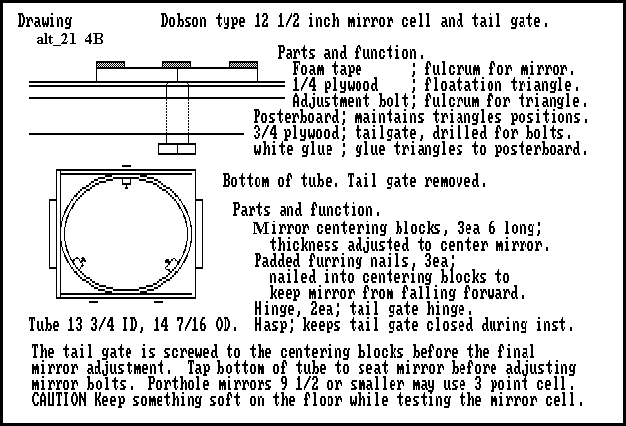Building the Telescope alt_21.htm
Overall picture 1A
Base and Tube together 2A
Tube breakdown 2B
Base breakdown 2C
Diagonal size 3A
Spider and diagonal 3BBuilding and Installing an Eyepiece and Camera
Mirror cell design 4A
Dobson Mirror Cell 4BCollimation - Aligning the Telescope
Telescope Makers don't always agree
Cardboard Tube/Truss Tube
Nothing / Dome / Roll Off Roof
Masonry Observatories / Insulated ObservatoriesOn my 12 1/2 inch telescope the tube box does not extend all the way to the bottom of the tube. This support is necessary on larger Dobsonians but not necessary on a 12 1/2 inch. Looking at my telescope I see that the tube clears the rotating baseboard by 1 3/4 inch when the tube is pointed straight up. When the tube is about 20 degrees off of vertical it clears the rotating base by only 1/2 inch.
The tube needs to be at least two inches bigger than the mirror to allow for off axis stars.
The 'Trackball Telescope'
An old concept revisited. Also refer to articles in 'Sky and Telescope'
and 'Astronomy Technology' for more globe based designs.
If the available diagonals don't match the size you need go to the next size larger.
In Sky and Telescope Magazine, August , 2000, page 120 you will find an excellent article on 'Sizing Up the Newtonian Secondary'. In simplest terms divide the distance from the center of the telescope tube to the focal plane = L by the telescope F number. Add 1/2 inch to this diagonal size then use a diagonal that is this size or up to 1/4 inch larger. For example an eight inch F6 telescope with the distance from the center of the tube to the focal plane in front of the eyepiece = 7 inches use a diagonal that is 1 3/4 inches to 2 inches.
7 / F6 = 1.166 inch minimum size. Plus 1/2 inch so the edge of the eyepiece field will be bright.
NOTE: When you buy a diagonal the size is the width and not the length. So in the example above with the 12 1/2 inch mirror you would tell them you want a 2 inch diagonal. In the 'Surf Program' there is a calculator for diagonal size.
We have coated many 2 inch by 3 inch rectangles of plate glass for use as diagonals. True, you can see more diffraction but if all you wanted to see was the rings of Saturn, no problem.
Before installing the diagonal spray paint the cardboard tube black opposite the eyepiece hole. The moon or street lights shinning into the tube in this area will cause loss of contrast. Some people worry about light scattered from scratches or chips on the primary mirror. Don't worry about this, most of the light scattered from these locations never gets near the eyepiece.
Building and Installing an Eyepiece and Camera
Building a simple three point mirror cell.
Building a nine point mirror cell.
Designing mirror cells for large thin mirrors using PLOP program.
Scientific American ATM books, Mechanical Flotation of Mirrors
Mirror cells, helpful Suggestions
When designing the mirror cell the mirror should be 'floating' meaning that there is no stress on the mirror. The mirror seems very rigid in terms of hundredths of an inch but in terms of wavelengths of light it is very floppy. Do not bend or pressure the mirror in its mount. Even a few pounds of pressure will be enough to bend the mirror a few wavelengths. The problem of flexing increases with the cube of the mirror diameter. At one time I was told that glass is a very viscous fluid. If so glass must be very viscous indeed because the figure of my 12 1/2 inch has not changed in 30 years.
There are novel ways of mounting the mirror at low cost. Sixteen inch port hole mirrors have been rested on Astro Turf for back support. For better support for the mirror edge on an alt azimuth Dobson style telescopes use a cloth belt or cargo strap around the bottom secured at the sides to blocks attached to the tail gate.
Collimation - Aligning the Telescope
The eyepiece tube must be mounted on the main tube so the light from the diagonal travels straight through the eyepiece and not at an angle. Make sure the eyepiece tube is mounted straight on the main tube. Roll up a piece of paper and slip it into the eyepiece tube and work the focus mechanism. Looking from the top of the main tube the paper should stay centered on the diagonal. Put foil over the eyepiece tube and poke a hole in it with a pencil. Looking in you should see the entire mirror reflected in the diagonal.
If you have put a colored dot in the center of the main mirror tip the scope up and tap the bottom to seat the mirror on the tail gate bolts. Caution, before doing this make sure the spider is secure. Adjust the tail gate bolts until the reflection of the diagonal is centered on the colored dot in the center of the primary.
For pictures showing collimation see the collimation page.
For more about telescope alignment refer to alt_51.
